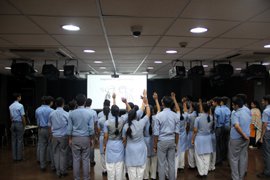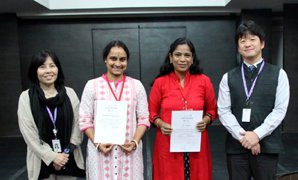The Work at The Japan Foundation, New Delhi (JFND)
The Japan Foundation, New Delhi
KONISHI Hiroaki, IMOTO Mami, MORRIS NAKAISHI Ayumi, and SAKEMI Shinako
India's Northern, Eastern, and Northeastern Regions
Due to India's large land area, this report is also written for three of India’s geographic regions: the Northern, Southern, and Western regions. I am in charge of the Northern region, but, in actuality, this article includes India's Northern, Eastern, and Northeastern regions.
The Eastern region is West Bengal, Odisha, and Bihar, etc. We have 12 hours of teacher training once a year in Kolkata, the capital city of West Bengal. There are many veteran teachers in the area, but they don't really have many opportunities to use Japanese, so we plan on holding the trainings that are based on actual situations. Also, there is the town of Shantiniketan, as well as Visva-Bharati (University) about 200 kilometers north of Kolkata. The university was founded by Nobel Prize-winning poet Rabindranath Tagore, and also held the first Japanese-language classes in India. Here, we hold a 30-hour teacher training course once a year, and participants learn the basics of teaching the Japanese language, primarily to undergraduate and graduate students at the university.
The Northeastern region is located in the northeastern region of Kolkata, across from Bangladesh, and is called the "Seven Sister States." We think that the city of Imphal, in Manipur state, is familiar to Japanese people. The Japanese course at Manipur University began in 2018. The Manipur Minister of Education also wants to begin Japanese courses at secondary educational institutions, and we think that chances to learn the Japanese language will steadily increase in the future.
Japanese-Language Education in Elementary and Secondary Schools! Swagatam JFND
Hello! I am IMOTO Mami, a Japanese-Language Specialist, and I oversee primary and secondary educational institutions. In this article, I will introduce one of my duties, "Swagatam JFND (Welcome to JFND)."
At elementary and secondary schools in India, the Japanese language is offered as an official subject and as a club activity. However, there are many schools that have not yet implemented Japanese-language education. Therefore, there is Swagatam JFND as one way of promoting the Japanese language. Of course, we also target schools that already do Japanese-language education, and holding Swagatam JFND at these schools is one way to continue their motivation to study the Japanese language and give them a chance to view Japanese society.

Swagatam (Students answer quizzes about Japan and the Japanese language)
The program has a variety of content, such as Shodo (calligraphy), Bon festival dances, Yukata (traditional summer kimono), Origami, Making Kendama (a traditional toy), and greetings in Japanese. Recently, we had a Shodo teacher come to India as a lecturer, and they did Shodo. Speaking of spring, the students made their own calendar by first practicing the kanji for "Sakura (桜; cherry blossoms)" many times and then cleanly writing it onto their own calendar. Even though it is just a single kanji character, it makes for a good calendar which expresses each student's individuality.
We will continue working hard so that students think, even if just a little bit, "I want to start Japanese-language classes at school and Japanese club activities" or "I want to continue studying the Japanese language."
A "Marugoto: Japanese Language and Culture" Circle that Surpasses India
Namaskar! My name is MORRIS NAKAISHI Ayumi, and I am in charge of the Japanese-language course. We hold workshops around India to spread the "Marugoto: Japanese Language and Culture" (hereinafter “Marugoto”) textbook, Japanese-language teaching materials. Until now, there has been a dilemma in which schools and teachers wanted to use the "Marugoto" textbooks, but they didn't have them and they were difficult to obtain. During my term, local publishing of the "Marugoto" textbooks went well, and now the “Marugoto” textbooks from Starter to Elementary 2 (A2) can be bought in India as well. If we have textbooks, then we can train the teachers who will teach using it, so two individuals, Ms. Gayathri and Ms. Geetha from the city of Chennai, where there are many educational institutions using "Marugoto," received and successfully completed the intensive training. The two of them, who were away from their families, took a break from their work, participated in the two-week training, diligently worked during the class tours and practical training, and were very inspiring to the teachers of other courses. It seems that one of the great results from this training is that they could understand the teaching methods of and questions about "Marugoto" that cannot be conveyed in the two-day workshops. In 2019, we also plan to have teachers from Nepal and Bangladesh participate in the training in Delhi. Additionally, we will also offer the JF Japanese e-learning Minato tutorial course, which will be the first step in how to teach with "Marugoto." Through these efforts, the "Marugoto" circle is getting bigger and bigger.

Ms. Gayathri (left) and Ms. Geetha (right), who came to the training from the city of Chennai
Aim to be Japanese-Language Teachers!
We are working with the Japanese Language Teachers' Training Centre to train 1,000 Japanese-language teachers in five years. The Centre was established on September 14, 2017, when Prime Minister Abe visited India and issued a Japan-India Joint Statement. Our aim is to increase the number of Indian teachers who can teach Japanese. The governments of Japan and India are expected to deepen Japan-India exchanges and to strengthen industrial cooperation.
In this article, I would like to introduce Course A, which is for individuals who will be teaching Japanese for the first time.
Course A is taught daily for a period of three months, and there are a lot of new things to learn about Japanese language teaching methods, such as speaking, letters/vocabulary, and grammar. Additionally, we also hold cultural experience classes such as for Yukata wearing and Bon festival dancing. Then, at the end of the course, the participants stand at the podium in front of a class and give lessons to real students. The participants, who until now had been students, are required to think and act as teachers in this course.
There are many group activities in Course A. Some students think that they can become good teachers if they have knowledge of Japanese and can teach well, but we chose this course design because we wanted the participants to know the importance of abilities such as cooperation and patience.
We interact with the students every day, and we hope that they will become teachers who can think and act for themselves.
I hope that the day will come when there are many Japanese-language teachers who can support students' dreams and play an active role in India in the future.
- What We Do Top
- Arts and Cultural Exchange [Culture]
- Japanese-Language Education Overseas [Language]
- Japanese-Language Education Overseas [Language] Top
- Learn Japanese-language
- Teach Japanese-language
- Take Japanese-Language Test
- Know about Japanese-language education abroad
- The Japanese-Language Institute, Urawa
- The Japanese-Language Institute, Kansai
- Japanese-Language Programs for Foreign Specified Skilled Worker Candidates
- Japanese Language Education for Japanese Children Resident Overseas and for the Descendants of Migrants
- Archives
- Japanese Studies and Global Partnerships [Dialogue]
- JF digital collection
- Other Programs / Programs to Commemorate Exchange Year
- Awards and Prizes
- Publications
